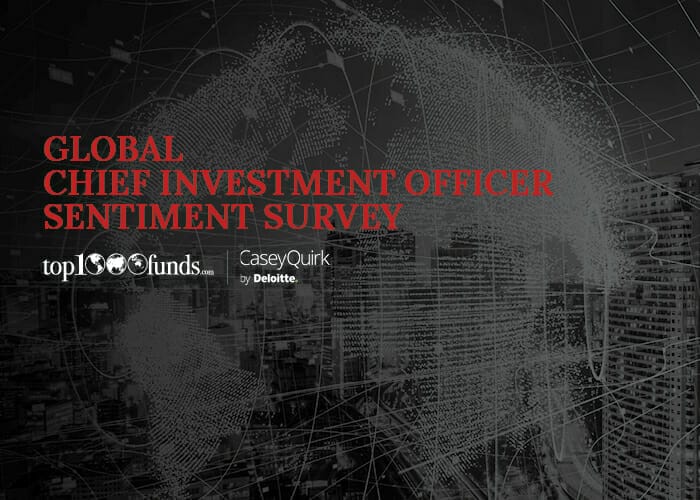The annual Chief Investment Officer Sentiment Survey, conducted by conexust1f.flywheelstaging.com and Casey Quirk, a practice of Deloitte Consulting, has revealed a global asset owner community that is less tolerant of risk and more interested in negotiating fees.
Now in its fifth year, the survey gauges the tolerance of CIOs across a number of leading indicators. This year, survey respondents totalled 77 CIOs with $2.3 trillion in combined assets across 11 countries.
Risks and asset allocation
Falling equity markets were identified by respondents as the biggest risk to their portfolios in the year ahead, with nearly 20 per cent of respondents ranking them as the biggest risk.
This was followed by overvaluation in equities markets, rising interest rates and slowing global growth.
Respondents were also concerned about geopolitical risks and the impact on economic stability affecting their ability to meet their commitments. Specifically, China tensions and US politics were identified as the top geopolitical risks in the year ahead.
Across the entire respondent universe, the investors had an average return target of 4.4 per cent. This ranged from 7.75 per cent to as low as 1.2 per cent.
Confidence in meeting targets this year was muted. Less than half of respondents (44 per cent) were confident of meeting their return target. Confidence in achieving targets has fallen quite significantly over the last year, as 57 per cent of respondents in the 2018 survey were confident in achieving their return targets. That’s a fall of 23 per cent for the year.
But despite the lack of confidence in meeting return targets, respondents are cautious and, generally speaking, are not willing to take on more risk to achieve their targets. Only one in 10 said they would take on more risk.
This decreasing risk tolerance has been a gradual and steady trend. Over the past three years, respondents have become less willing to take on risks with those willing to take on more risk falling from 35 per cent in 2017 to 10 per cent this year.
Tyler Cloherty, head of the knowledge centre at Casey Quirk/Deloitte which has been partnering with Top1000funds.com for five years on the CIO Sentiment Survey, said this year’s survey revealed an interesting conflict around risk.
“One of the interesting things in this year’s survey was the ‘risk off’ nature and the willingness, or lack of it, to extend risk,” he said. “There is more conservatism in the overall approach from asset owners, you can see that in their projected allocations. There is little willingness to take risk in listed markets, but there is no slowdown of the willingness to take on more illiquidity exposures.”
To this end, one respondent said: “We are slowly de-risking, so new investments are selective nuanced strategies where managers have unique selling propositions enabling them to continue to add value in a market where assets are over-priced.”
Chloe Gardner, senior consultant at Casey Quirk, said the survey showed the shift in asset owners’ risk budgets where they are not taking on more equity risk but there is more diversification.
Overwhelmingly, asset owners are looking to infrastructure and other real assets in their asset allocation, with 41.2 per cent of respondents intending to allocate to that asset class, this was followed closely by private equity and venture capital, where a third of respondents are looking at allocating more.
Global and domestic equities were the least likely asset class to receive more allocations.
“There is tremendous global demand for private equity,” Cloherty said. “If investors do take equity risk, they are more likely to take that in private equity not listed markets. They see private equity as still worth the premium.”
Just over a quarter (26.1 per cent) of respondents plan to move more of their portfolio to passive or smart beta in the next three years.
The trend to insourcing investments appears to continue with 41.8 per cent of respondents saying that they have recently in-sourced or plan to in-source more of their investment capabilities. Control and costs are the primary reason for the move.
Costs and pricing
There was a divergence in responses when it came to questions around costs and fees. Around one-third of respondents said fees had increased, while a similar proportion said fees had decreased. Of respondents, 44 per cent said reducing costs was either extremely or very important.
Of those with rising investment costs, the most popular driver for increased or stable investment costs was the use of more high-fee products, with 52 per cent of respondents attributing rising costs to this.
A massive 86 per cent of asset-owner respondents said they were using negotiation as a way of reducing investment costs. A quarter were also using passive and smart-beta strategies to lower costs.
Respondents were asked to list their most preferred pricing structure and a performance-based fee with a smaller management fee the most popular (37 per cent). Most respondents had a mix of this type of fee structure alongside a flat fee for the majority of their assets.
Casey Quirk’s Cloherty said there were a couple of key impediments to moving to more innovative pricing structures.
“A willingness to negotiate down existing fee structures is omnipresent,” he said. “Often, negotiation starts with a new pricing structure but ends up with a discount on more normal pricing structures. In addition, alternative fee structures are hard to communicate to the board. There is also a risk that in a low-return environment, the fund will have a low return but end up paying out big fees to a manager because they have outperformed their mandate.”
He said managers also had some reservations about new innovative pricing structures, including concerns over revenue volatility and valuations.
“If there is going to be a move to more innovative structures, this needs to be driven by asset owners,” he said. “A performance fee is a more logical and philosophical way to pay for asset management, where you pay for value, and position against commoditisation (of beta).”
Manager relationships
The survey shows that asset owners are reducing the number of managers they have relationships with, with nearly 40 per cent indicating this direction.
On average, the respondents had 75 manager relationships, but this varied widely. A $200 billion US public pension plan had 300 manager relationships, while a $2.5 billion Papua New Guinea fund had only three manager relationships.
When asked if they considered any of their managers to be strategic partners, about three in five respondents said yes. Access to key investment professionals and customisation of products were the two most important factors from asset manager partnerships.
“Asset owners want to work with managers that are high quality, allow access to their teams, provide customisation and [facilitate] long-term relationships,” Cloherty said.
There are a number of lessons in this survey for managers. First, the decreasing number of manager relationships is making the environment more competitive for managers.
Casey Quirk’s Gardner noted that as asset owners become more complex, competitive differentiators are becoming more important for managers.
“Managers need to serve an investor on a more holistic basis, which includes giving them access to research, providing advanced risk management and a better client portal. Better service means catering to what the owner needs and is much less product oriented,” she said.
There is not a huge amount of growth for managers in the global institutional investment environment, Cloherty said, so managers should maximise retention.
“Be present, don’t be transactional,” he advised. “Extend the life, and reach, of the relationship. There is a lot more work involved and it is more costly for managers but asset owners want it for less. The question to ask is, ‘How do you deliver beyond just alpha?’ ”
For the results of last year’s CIO Sentiment Survey click here.



